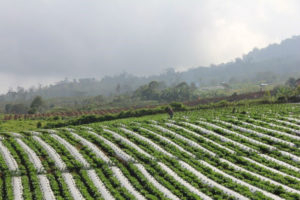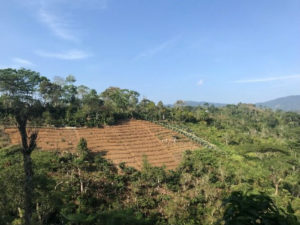Blog post prepared by Sacha Amaruzaman
In Indonesia, there are some 48 million people in 32,000 villages living in and around forest boundaries. The majority of these households rely on upland landscapes for subsistence, livelihoods and economic development. Loss of agricultural productivity and ecosystem services leads to reduced incomes followed by increased poverty and food insecurity in a downward spiral and poverty trap. This process leads to increased deforestation as new land is brought into agriculture to make up for the lost productivity of the degraded lands. The economic impacts of not addressing Indonesia’s land degradation are significant. An important research gap in the study of Indonesia’s upland catchments is the lack of recent analysis examining how economic policies shape farm household land use decisions.

Intensive agriculture in the uplands of Pagar Alam, North Sumatra
The IndoGreen project funded by the Australian Centre for International Agricultural Research (ACIAR) and led by Prof. Randy Stringer of GFAR aims to understand how existing national and local policies (e.g., public investments, property rights, extension, fertiliser and water subsidies, trade policies, and taxes) influence farm household decisions that result in these environmental externalities. The research seeks to identify how alternative policies and incentive strategies can improve economic, social and environmental outcomes.

Intensive agriculture in the uplands of Pagar Alam, North Sumatra
As part of the project, Sacha Amaruzaman, GFAR PhD student, and Henri Perkasa, GFAR Research Associate, recently undertook key-informant interviews the in August in one of the IndoGreen project sites in Pagar Alam District, South Sumatra. The visit aimed to gather detailed information on the policies that impact the agricultural landscape and ecosystem services in Pagar Alam and prepare the focus group discussions with the beneficiary farmers of the policies.

Sacha and Henri interviewing the farmers
Pagar Alam’s upland landscape, dominated by the coffee agroforestry system, is experiencing high pressure from the expansion of intensive farming practices in the steep slopes and forest area, as well as the upcoming reservoir construction that will lead to the land-use conversion from tree-based system towards the rice fields.
Two major policies were identified as the focus of research in Pagar Alam, namely the Community Forestry Scheme and the Reservoir for Rice Field irrigation.
Through the IndoGreen project, funded by ACIAR and managed by GFAR and the World Agroforestry Centre (ICRAF) the research is aiming to evaluating the impact of the policies in the upland landscape of Pagar Alam, to identify the trade-off between the environmental condition and farmers’ livelihood and provide alternative policies that balance the two components.
As a part of his thesis, Sacha will do the Focus Group Discussion in September followed by a Household Survey in Pagar Alam in early 2019.

